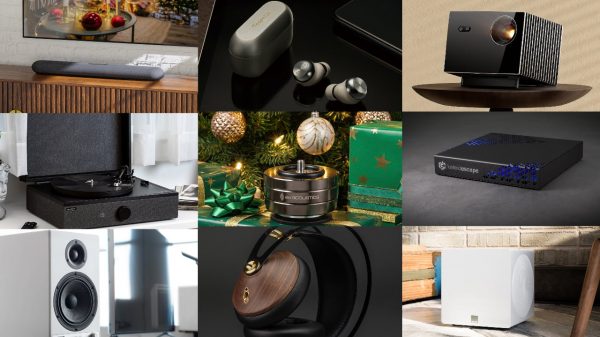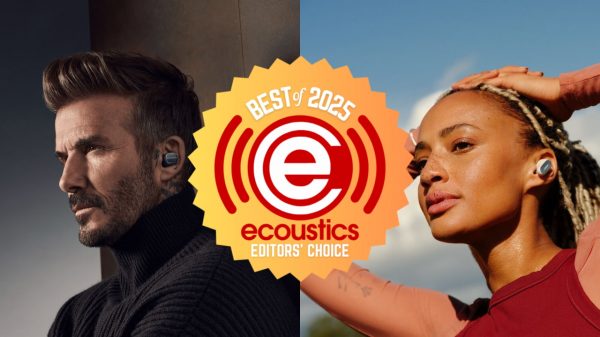Over the years, very few high-end loudspeaker brands have attempted and succeeded at engineering wireless earbuds and headphones that deliver a sonic experience that matches the name. Just because they are great at making loudspeakers does not guarantee that they can repeat that in the aforementioned categories.
DALI has only recently proven that it can offer excellent wireless headphones and Focal took the long-term approach with the award-winning Bathys. Bowers & Wilkins has proven that it can deliver great sounding wireless headphones and earbuds which makes them rather unique.
The Px7 S2e recently earned our “Best Wireless Headphones” designation under $400 and we were very impressed with the new Bowers & Wilkins Pi8 Wireless Earbuds; only some connectivity issues with specific source devices kept the Pi8 off the leaderboard in the “Best Wireless Earbuds” category.
The $400 Pi8 represent the flagship model, which might put them out of reach for some listeners, but with the Bowers & Wilkins Pi6 being priced at $249, we thought it made sense to judge just how close they come to the Pi8 and other models below $300.

Build and Fit
Understated is the word of the day with the Pi6 when it comes to its packaging and it is clear that Bowers & Wilkins see this as a more mass market product on that front.
Once unboxed, the Pi6 comes equipped with a charging case (earpieces already inside), a cardboard insert with extra small, small, and large ear tips, and users will discover that the medium sized ear tips have been pre-installed.
The 24-inch USB Type-C charging cable is color matched to the ear pieces and charging case and users have the option of 4 coloways; Cloud Gray, Forest Green, Glacier Blue, and Storm Grey.
The Pi6 and Pi8 share rather subtle visual differences and it’s clear that the different models use variations in color shading to differentiate them; both use the same charging case and are the same size so it’s logical that some might confuse them.
The earpieces are a totally new style and more conventional than the previous generation with an oval shaped face and body with a slight lip at the junction of the body and the underside that helps hold the earpieces snugly in place.
One similarity to the previous generation is that the Pi6 requires a slight twist as its placed into the ear to lock that lip in place. With the IPX54 rating, that locking mechanism becomes increasingly important as the Pi6 have the potential to be a rather solid option for the gym.
Nozzles sit at the top front of the inner face with an upward rake so the bulk of the body sits both behind and below the ear canal. A closer look at the junction of the faceplate and body reveals a series of functional vents that could easily pass for a decorative band if not scrutinized more closely.

The case is a bit more conventional as well with a top-opening clamshell design and a USB Type-C port on the bottom face. This a personal pet peeve and seemingly an industry standard, but why can’t manufacturers design a case that will stand and charge at the same time?
The rounded edges make it more comfortable in a pocket but also mean it barely balances upright with the lid closed and cannot stand with it open. With the charging port on bottom, the case has to be laid on its face to charge.
With the LED charging indicator on the front face, users will want to lay the case on its rear face so it can charge and the indicator remain visible.
Overall, the Pi6 is a more conventional design given the B&W treatment with small nuances like the locking mechanism and the rounded corners showing that the designers were also users of the product.
I found the earpieces to be quite comfortable and somewhat improved over the previous generation for extended listening; the earpieces are lighter and the shape an easier fit for my ear.

Internals
Inside the earpieces, the Pi6 use a 12mm dynamic driver with a bio-cellulose diaphragm representing a 3mm increase over drivers used in the previous iteration; they help reduce distortion while hoping to enhance high-frequency detail, as well as clarity throughout its sound signature
The nominal impedance and sensitivity were not provided but with the electronics handling all the amplification, knowing those numbers is far less critical when using a TWS so the trend of not publishing that information has become quite common in this segment.
With the overall shell being equal or smaller than the previous generation and the driver being larger, you would expect them to give up something in the trade, but the Pi6 still utilizes 3 microphones inside each shell for both phone calls and ANC.
The Pi6 feature Bluetooth 5.4 which supports aptX Adaptive, AAC, and SBC — and that’s where we ran into some trouble during our testing.

Connectivity
The Pi6 proved to be a mixed bag when it comes to connectivity; we either had rock solid connections with some source devices or really poor connections that included drop-outs with the source device in my hand and no obstacles or extended ranges at all.
After some comprehensive testing, I tracked down the issue and believe that it has more to do with the source device’s implementation of aptX than the earpieces.
Connectivity with SBC or AAC was always good (within normal ranges) but performance with aptX was all over the map; the Samsung S20, S22 and S24 exhibited poor connectivity.
We moved on to the OnePlus 12 and there were no issues with Bluetooth aptX.
I dug out an older OnePlus 9 and that phone proved to be very reliable with aptX, but then when we switched to a Moto G Power 5G and the drop-outs issue reared its ugly face again.
When I went back to the Samsung S24 and switched to AAC in the Developer options, the only issue was that I was limited to the available bit-rates.


Control App
Pairing is straight forward, but you will need the B&W Music App to access most of the features. The manual provides links for the appropriate app store but users of previous generation products may be inclined to skip that step as they already have a B&W app installed.
The bad news is the older B&W App will not support the latest wireless earbuds so you’ll wind up seeing a message in the app pointing the user to the new download.
The control app provides access to change the touch controls which I did immediately since the default controls ANC rather than volume and play/pause which is my preference.
The app also provides access to the ANC modes, wear detection function, and a rather basic 2-channel EQ setting.
One thing to note is that software updates are through the Settings page; which is accessible before changing the Pi6’s controls by clicking on the Pi6 at the top of the page.
The process felt somewhat counter-intuitive, but there is an update now available that promises to address some of the connectivity issues that were uncovered.
Something that’s really important to know is that you should not wear the Pi6 when conducting any kind of update; there is a rather pronounced pop that occurs as the power cycles at the end of the update and it could potentially damage your hearing.

Battery Performance
According to Bowers & Wilkins, the Pi6 are designed to provide 8 hours of battery life from a full charge with an additional two charges from the charging case before requiring the USB cable to start all over again.
We found those numbers to be slightly ambitious; our multiple series of tests yielded closer to 7 hours at average volume levels with some variance depending on the codec being used and ANC usage.
That result is still rather respectable and the quick charge feature produced an additional 2 hours of battery life after only 15 minutes of charging.
Fully recharging the earpieces runs closer to 2 hours and recharging the case took around the same amount of time depending on the charger being used; we used an Amazon 68w two-port GaN charger during our testing.

Listening notes
The last two generations of Bowers & Wilkins TWS earbuds (Pi7 and Pi7 S2) made our “Best of” lists because they delivered very good sound quality and ANC performance that was better than average without ruining the listening experience.
The Pi6 utilize a larger and more advanced driver so my expectation was that they would deliver consistent low end response that hit even harder with EDM, hip-hop, and other bass heavy tracks.
The bass response certainly met my expectations with a center around 120Hz with a gradual drop on either side. The sub
The sub-bass range delivers impact but without a lot of texture and can become a bit much if you don’t utilize the EQ to dial it back somewhat. The mid-bass is still rather strong when it comes to overall impact but features more texture and using the EQ allowed us to tighten things up somewhat and the overall presentation was cleaner. Compared to the Pi8, the bass range lacked some definition and detail, but those looking for a rather strong degree of impact will not be disappointed.
The lower midrange comes across as slightly recessed and warmer sounding overall due to the added emphasis in the mid and upper bass range, but there was a noticeable improvement in overall clarity and detail.
Male vocals had enough weight and texture, but also struggled somewhat to cut through the instrumentation with some tracks. Guitar notes have adequate growl but some of the edge is lost because of the additional warmth that bleeds into the range and blunts some of the edge.
Acoustic guitar and lower string instruments did better overall on most recordings; the additional warmth and detail make them stand out and push them slightly forward.
Female vocals cut through the instrumentation better than their male counterparts; most tracks came across with better clarity and detail and the lift in the upper midrange moved them forward of the mix and improved their sense of focus.
The upper midrange lift continues into the lower treble before rolling off somewhat, resulting in a somewhat polite sounding treble range. The lower treble has a slight lift that helps with with percussion snap, but the lack of energy above that keeps cymbals from being fully realistic.
Will that prove to be a good thing for most listeners?
The upside is that whilst the Pi6 features somewhat of a ‘V’ tuning, the overall balance is not bright sounding or fatiguing which is often the case when manufacturers try to match the upper ranges of the ‘V’ in level. There is more than enough top end energy to provide some sense of airiness and clarity to the mix, but without trying to balance out the more pronounced low end.
Soundstage performance is a mixed bag somewhat; the overall width is acceptable for a pair of TWS earbuds, but at the expense of depth and height. Seating the orchestra results in a shallower sounding layout, but instrumentation separation is good enough to keep things from sounding too cramped.
There is also some compression evident in the bass range as music becomes more complex, but it should not become a distraction unless one listens at excess levels.
Overall imaging is above average with movements around the soundstage easily tracked but listeners should be aware that the issues with aptX connectivity will impact low latency support, resulting in movies and gaming not coming across as perfectly in sync with the sound.

ANC Performance
The overall ANC performance is quite good and that should be interpreted as meaning that the Pi6 does a rather commendable job of reducing exterior noise whilst not impacting the sound quality.
The Pi6 has moderately effective passive isolation and requires the help of ANC to handle noise from vacuum cleaners, and the train whilst commuting. The combination of ANC and passive isolation does a good job at reducing droning noises to a level low enough to be ignorable while not changing the signature in order to do so; wind noise is reduced but can’t be completely eliminated and does occasionally bleed through.
We compared the Pi6 to the previous iteration and felt that the ANC was more effective with less of an impact on the sound quality; the new design features a different positioning of the microphones which helped reduce external noise and improved phone call quality.

The Bottom Line
The Bowers & Wilkins Pi6 offer a lot of value and performance for the money and will make sense for those whose listening tastes align with the tonal balance and overall presentation. The Pi6 is clearly tuned for more popular genres that favour a tilted balance in the bass range which will make them a good option for those who enjoy EDM, pop, and hip-hop.
The ANC works rather effectively without degrading the sonic performance and that’s good to see in a pair of TWS earbuds at $249; that should be the case for any wireless earbud with ANC but we know that isn’t the reality in 2025.
The connectivity issues with Bluetooth aptX are problematic depending on your source device and based on the frequency of firmware updates — it is our expectation that Bowers & Wilkins will fix this issue in the near future.
Having to use AAC is not a deal breaker unless you really must have aptX Adaptive.
Is there a huge difference between the Pi6 and more expensive Pi8 when it comes to overall sonic performance? The more expensive model comes closer to a reference tuning and offers a lot more detail that makes it sound more open and spacious — the soundstage is both wider and deeper sounding.
Pros:
- Solid bass response
- Polite sounding treble makes them easy to listen to during longer listening sessions
- Very good seal and they stay in place when you exercise
- Solid ANC performance
Cons:
- Soundstage is somewhat constricted
- Connectivity issues using aptX with specific source devices
- Touch sensors are somewhat finicky to use
Where to buy:
Related Articles:



































